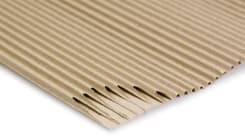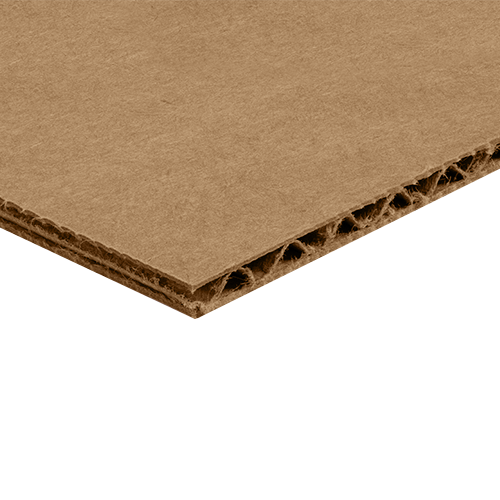Corrugated Cardboard
Corrugated cardboard is a highly versatile packaging material used extensively in various industries. It comprises three layers of paper, with the top and bottom layers being smooth and flat and the middle layer comprising parallel arched paper strips called flutes. These flutes are shaped like waves with peaks and valleys. They are then glued between the outer layers, creating a robust and solid structure. Corrugated cardboard is lightweight, cost-effective, easy to manufacture, and strong and durable. This makes it ideal for various applications such as product packaging, shipping boxes, toys, furniture, displays, and other products. Moreover, it is eco-friendly as it is recyclable and biodegradable, making it a sustainable option for companies that aim to reduce their environmental impact.
Material Types of the Liner Paperboard of Corrugated Board
Two main types of paper are used for corrugated boxes and packaging liners: Kraft and Test liners. Kraft paper is made from softwood trees and is the most critical type for producing corrugated boxes. It is the easiest to print on and is commonly used for the outside liner. On the other hand, test paper is made from recycled materials and is not as strong as Kraft. It is widely used for the inside liner and is less expensive. Each liner type comprises a crucial layer for adhesion and strength and a finer “cover” layer for improved aesthetics and printing.
Apart from Kraft and Test liners, other options are available for cardboard manufacturing. The paper grades for outer and inner liners include:
- Virgin Kraft paper
- Partly recycled liner paper (TEST 2)
- Fully recycled liner (TEST 3)
- Waste-based liners (CHIP)
- Fully bleached Kraft liner (FULLY BLEACHED WHITE)
- White-coated recycled liner (WHITE TOP)
- Mottled white Kraft (MOTTLED KRAFT)
- Mottled test liner (OYSTER)
- Virgin fibers using neutral sulfite semi-chemical process (SEMI CHEM).
The final two paper types listed are commonly used for flutes and less frequently used for liners. It is important to note that this list is incomplete, and several other specialist papers are available.
Materials of the Core Wavy Paperboard of Corrugated Board
The core wavy paperboard, also known as "flute", is made of a wavy paperboard, typically a fully recycled liner (TEST 3, [ WBF ] - Wasted Based Fluting, or what is known as semi-chem fluting [ SC ]) that weighs 0.026 pounds per square foot (130 grams per square meter) in the US and 90 grams per square meter (0.018 lb/sq ft) fluting paper in the UK. The paperboard is heated, moistened, and formed into a fluted pattern on geared wheels at the single-facer.
Commonly used paper weights are as follows:
- 90 GSM WBF
- 105 GSM WBF
- 112 SC and WBF
- 150 SC and WBF
- 175 SC and F
The middle fluting in corrugated cardboard gives it strength and rigidity. The arch shape of the flutes also supports and prevents the cardboard from collapsing or crushing under pressure. The air pockets the flutes create make corrugated cardboard an excellent insulator, helping maintain a consistent temperature during shipping and storage. This makes it perfect for transporting perishable goods.
Understand Corrugated Board Grades Number
It's important to understand the different grades of corrugated board so that you can describe the board type being used accurately. To do this, you need to know the weight of the outer and inner liner, as well as the type of flute used.
For instance, if your material grade uses a 125gsm Kraft outer liner, a 125gsm Test inner liner, and a B flute, you would describe it as 125K/B/125T. If you have a material grade with a 150 Test outer liner, a 150 Test inner liner, and an E flute, you would describe it as 150T/E/150T.
This terminology is widely understood by packaging manufacturers and will help you to fully understand the type of material your cartons are made from.
Types of Corrugated Cardboard
Different types of corrugated cardboard are available, each with unique characteristics that make them suitable for different applications. The most commonly used types in the packaging industry include single-wall and double-wall corrugated boards.



1. Single-wall corrugated cardboard comes in five types:
- 1.1 E-flute:
It is the thinnest and most delicate, with a thickness of just 1/16-inch. It is commonly used for primary packaging or direct mailers. - 1.2 F-flute:
It is even thinner and lighter than E-flute, with a thickness of just 1/32-inch. It is commonly used for primary packaging. Its smooth and sleek surface enhances the appearance of printed graphics and text, making it ideal for retail and point-of-purchase displays. - 1.3 A-flute:
It is the most commonly used corrugated cardboard for shipping boxes, with a thickness of 1/8-inch. It is used for secondary packaging. - 1.4 B-flute:
It is thicker than A-flute and provides more cushioning and protection, with a thickness of 3/16-inch. It is used for secondary packaging. - 1.5 C-flute:
It is the densest type and provides the most durability and strength, with a thickness of 5/16 inches. Additionally, corrugated cardboard can be glued together to form duplex corrugated cardboard, such as the E-E or E-B flute. It is used for secondary packaging.
2. Double-wall corrugated cardboard comes in two types:
- 2.1 BC-flute:
This double wall material combines B and C flutes, 6mm to 7mm thick. This gives an excellent all-around performance, making it familiar to produce shipping boxes offering higher transit protection. It is used for secondary packaging or bulk primary packaging. Due to this, only basic print (such as flexographic) tends to be added. - 2.2 EB-flute:
Around 4mm to 4.5mm thick, the EB flute combines E and B flutes into a double-walled material. Due to utilizing both an excellent (E) and relatively large (B) flute, this grade provides an excellent balance between transit protection, strength, and print finish.
Terms of Corrugated Materials
Here is a list of technical terms related to corrugated board grades that you may find helpful in understanding the material better:
- Across Flute:
A unit of measurement used to measure corrugated material, such as Correx®, in the opposite direction of the flute (width). - Backing Liner:
A compressible paper material that compensates for any irregularities on the sealed surface. This material usually adheres to the liner and provides a better finish, water resistance, and extra strength. - Blank:
A flat piece of corrugated board that has been cut and scored, ready to make a box. - Board grade:
A grade given to corrugated board based on three elements: the weight and type of outer liner, the kind of flute, and the weight and type of inner liner. - Burst damage:
The term given to packaging containers that split or "burst" due to too much pressure, such as if stacked too high. - Carton Board:
Stiffer and thicker than boxboard, it has medium to high compression and moisture resistance. Unlike cardboard, it is solid and not fluted. - Chop Edge:
The length of the board/sheet. - Clay Coat:
A thin layer of kaolin coated onto the corrugated board to improve its printing surface and used on unbleached or natural Kraft paperboard. - Corrugated:
A material shaped into a series of parallel ridges and grooves. - Crush:
An edge crush test measures the cross-direction crushing of corrugated board. It provides information on a board's resistance to being crushed. - Deckle:
The width of the board being run on a corrugator. - Double wall board:
A combination of two layers of corrugated material (potentially different flute sizes) to provide a material with extra strength. - Duplex:
A type of paperboard made up of two layers. The exterior is often coated, which makes it more water-resistant. It is often used for paper cups and plates and in the pharmaceutical industry. - Edge crush test:
A corrugated board strength test of vertical crush resistance. - Enhanced Fluting:
A substitute to standard fluting that adds strength and performance to the material. - FEFCO:
The European Federation of Corrugated Board Manufacturers is a non-profit organization representing the interests of the corrugated industry. FEFCO case codes are standard design patterns used within the corrugated industry. - Fibre:
Packaging materials are made from molded fibers or pulp. - Flute:
Paper that provides the central layer in a corrugated board. It separates the liners and provides strength and rigidity. - Fluting profile:
The shape of the grooves within the corrugated material. - Grammage:
Also referred to as GSM, the weight of paper is specified as g/m2 (grams per square meter). - Kraft:
Brown paper or paperboard produced from the virgin pulp in the pulping process. It is made out of natural, unbleached wood fibers. - Light-weighting:
In packaging, light-weighting is the design of packages that reduce material use, weight, and cost while reducing environmental burden. - Liner:
One of the paper materials that makes up one part of the components in a corrugated board. There is an inner and outer liner; the outer liner is usually of higher quality due to being used for print finish. - Mottled:
A paper liner with an off-white appearance. - Single face:
One piece of fluting glued to one liner only. - Single-wall:
Or double-faced, single-walled board consists of one part fluted paper (in the middle) and then two materials (usually paperboard) bonded on either side of the fluted paper to give it strength. - Slit edge:
The edge of the sheet that has the flute running parallel with it. It is also known as the width of the material. - Test liner:
Recycled liner board that can be manufactured as a sheet with similar fibers. Known as Homogeneous/simpleplex or a combination of two layers with the outer layer being better quality recycled fiber, this is known as Duplex or Multi-Ply. - Tri-wall:
A triple-fluted corrugated board for its strength, flexibility, and eco-friendliness. - Virgin Material:
A material that has not been processed in any form other than its original manufacture. - Weight:
Refers to the density of a material. See GSM for further information.
Other References
What is natural kraft linerboard?
What is mottled white linerboard?
What is bleached white linerboard?
What is kemi white linerboard
